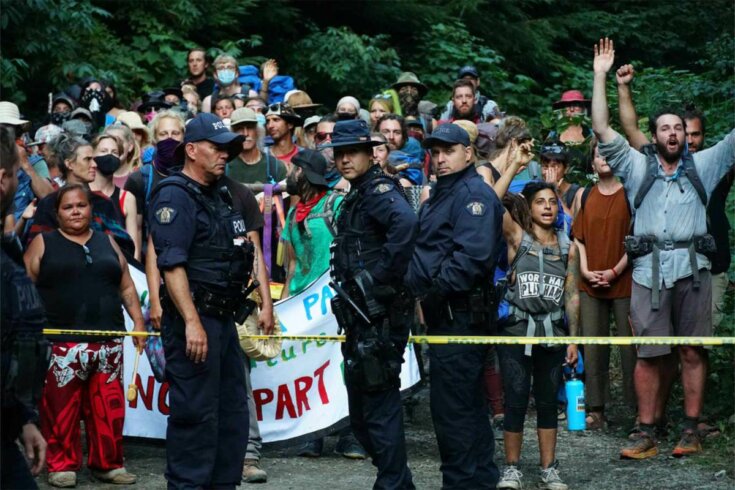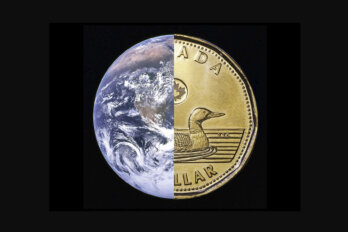In the spring of 2021, all eyes were on Fairy Creek, Vancouver Island. The valley, which contained one of the largest unbroken tracts of old-growth forest in the region, had become a political and ideological flashpoint as protesters had camped out for nearly a year to stop a logging company from cutting the forest.
Local, national, and international news agencies were sending reporters to the blockade; Victoria residents were making the two-hour pilgrimage, laden with donated groceries; and the British Columbia NDP government was ducking pointed questions in the legislature about the protests taking place in then premier John Horgan’s own riding. What had started as an attempt to prevent planned logging on a single mountainside turned into a national discussion about the twilight of rare—and lucrative—old-growth forests. The NDP, which had promised to protect old-growth forests, was on its heels.
On April 1, a provincial court granted an injunction to Teal Cedar Products, a subsidiary of Teal-Jones, the logging company that owned the rights to cut in the Fairy Creek watershed, making it illegal to block or restrict logging activity in the area. “[Interest in the protest] went through the roof,” recalls Torrance Coste, an environmental campaigner with the Vancouver-based Wilderness Committee. Although the RCMP didn’t begin arresting protesters until a month and a half later, the threat of arrest added a pressure to the protests. “There’s huge opposition to old-growth logging across BC—across the country—and people [were] willing to get arrested to send a message to government,” Coste says.
It was into that fraught atmosphere that a single-page statement appeared like an ideological bomb. On April 12, 2021, with a few words, the Pacheedaht First Nation took the wind out of the sails of what would later be identified as the largest act of civil disobedience in the country. “We do not welcome or support unsolicited involvement or interference by others in our Territory, including third-party activism,” the statement read. In spirit, the Pacheedaht’s statement, signed by the elected chief, Jeff Jones, and hereditary chief, Frank Queesto Jones, told protesters to leave.
At the same time, a Pacheedaht Elder, Bill Jones, who contests the hereditary chieftainship of Frank Queesto Jones, was steadfast in his support of the protests, which meant there were no longer any simple answers for the supporters or opponents of the protests. The statement complicated Fairy Creek’s industry-versus-environment standoff and the tidy assumption that a First Nation would be against old-growth logging in its territory.
The headlines were damning. The Times Colonist: “Pacheedaht First Nation says old-growth activists ‘not welcome’ in Fairy Creek area.” The CBC: “First Nation’s council and chief ask ‘3rd-party’ activists to stand down in BC logging dispute.” The Guardian: “Pacheedaht First Nation chiefs in Canada tell anti-logging protesters to leave their lands.” The Toronto Star: “Pacheedaht Nation wants Fairy Creek blockade to leave.” Horgan himself took the opportunity the next day to urge the protesters to “move along.”
Coste was out in the bush the day the statement was released, and he returned to cell service with his phone brimming with messages. “It was a big deal,” he recalls. “I know people that grappled with the decision [to support the protest] and decided not to go because of the letter.”
The statement came at a fortuitous time for the embattled NDP government, which has billions of dollars riding every year on a profitable forestry industry. But now, almost three years later, a freedom of information request and a lengthy legal battle reveal for the first time the evolution of the document—and evidence of possible influence by the BC government in shaping the tone and substance of the explosive statement.
On April 12, 2021, many members of the media first saw the Pacheedaht First Nation’s statement via Twitter, posted by BC MLA Nathan Cullen, then the provincial minister of state for lands and natural resource operations.
Within days of the statement being released, then Capital Daily reporter Kate Korte (I was managing editor of Capital Daily at the time) asked the government whether it had had any part in authoring or distributing the statement. Though the government denied having had any involvement in distribution, it did not comment on authorship, saying that “the Pacheedhaht [sic] speak for themselves.”
I filed a freedom of information request asking for any correspondence between the government and the Pacheedaht First Nation preceding the statement. A month later, I received emails that showed that the government had known about it ahead of time, had coordinated with the nation on the statement’s release, and may have had discussions about its content.
But one document was completely redacted: the draft of the statement. I appealed to the information and privacy commissioner of BC, who has the ability to force the release of documents that might be improperly redacted by public bodies, and more than two years later, the government was forced to release the draft.
According to email correspondence included in the draft’s release, in the afternoon of April 8—five days before the statement was made public—Rod Bealing, Pacheedaht First Nation’s forestry manager, sent a draft statement internally within the nation to elected chief Jeff Jones and a band manager, asking for suggestions. Five hours later, Bealing sent an email to Eric Kristianson, who was then assistant deputy minister for “strategic initiatives” in the BC premier’s office: “Please find our proposed statement attached. Please call if any questions,” Bealing wrote.
We don’t know if Bealing and Kristianson spoke over the phone; there are no records confirming or disproving it. Bealing, who no longer works for the First Nation, could not be reached for comment. (Kristianson did not respond to an interview request.) What we do know is that there are striking differences between the draft—written before the government saw it—and the final statement.
The draft was a broad statement outlining the Pacheedaht’s positions on forestry and resource stewardship. It outlines both the history and goals with regard to forest management in its territory. Criticism is directed at the Crown, the BC government, more than at any other party: “No Treaty has ever been concluded between the Crown and the Pacheedaht at all, and in particular regarding, lands, waters, airspace, resources, governance, or taxation. In failing to do so, the Crown and others have interfered with the culture and livelihood of the Pacheedaht Nation,” the draft read. The words “activism” or “activists” do not appear in the draft.
The final statement, however, became much more pointed toward the activists protesting at Fairy Creek. The line about the Crown was removed, and instead, the government was credited for commitments to “suspend and defer third-party forestry activities within specific areas identified by Pacheedaht.” This plan to defer logging in certain areas had appeared in less certain terms in the draft, with no reference to the government, but after the province had had a chance to provide feedback, the idea appeared to be on more solid ground and was backed up with promises of a plan for the “implementation of an immediate interim conservation measure.”
Overt criticism of the BC government was cut from the final statement. In its place, strong language undercutting the activist movement was added. The draft concluded with: “Pacheedaht . . . is not seeking, and does not welcome or support unsolicited involvement or interference from others.” The final statement’s conclusion, however, included key changes: “We do not welcome or support unsolicited involvement or interference by others in our Territory, including third-party activism. Pacheedaht needs to be left in peace to engage in our community-led stewardship planning process so that we can determine our own way forward as a strong and independent Nation.”
Both “third-party activism” and “Pacheedaht needs to be left in peace” were frequently quoted phrases in subsequent media coverage.
Taken as a whole, the final statement was a strident condemnation of the protests, was directly aligned with the province’s priorities, and was perfectly timed to deflate a growing and politically troublesome movement that was about to boil over. The draft had started off vague and broad, directing its criticisms at multiple players, including the government and unspecified third parties. It could be read as a statement of intent to pursue sovereignty and resource control just as easily as it could be read as a request for the time and space the First Nation needed to do so. The final statement was the opposite.
In the morning of Monday, April 12, Kristianson emailed Bealing asking for an update: “Rod, can you [let] me know when the release goes out?”
Bealing responds almost immediately: “Good morning Eric – we are sitting down with the chiefs right now. talk soon.” Just over four hours later, Cullen posted the statement on Twitter.
Further correspondence between Bealing and Kristianson in the days after the statement’s release makes clear the relationship between the two on this matter, in which Bealing shared a set of queries the First Nation had received from a reporter at CTV News and their responses. Kristianson forwards the responses to Evan Brown, the executive assistant for premier John Horgan, in which Kristianson requests: “Can you print for PJH please?”
The interaction regarding the Pacheedaht First Nation’s statement—the opening of a possible phone call and the clear knowledge of when the nation planned on releasing the statement—raises the question: How much did the province influence the changes between draft and final statement? A spokesperson for the BC government did not deny when it was asked if it helped shape the statement, instead writing in a comment to The Walrus that “the Province would not speak to details of government-to-government discussions with a First Nation.”
The government spent two and a half years fighting against the release of the draft document. Before the complaint process got underway in earnest, the information commissioner’s office tried to mediate the dispute, but the government didn’t budge, so the complaint went ahead. In formal submissions, the government’s lawyers argued that two exceptions—confidentiality and harm to intergovernmental relations—prevented it from releasing the draft. A sworn affidavit from Kristianson, attesting to his belief that the draft was received in confidence, was attached to a lengthy legal submission by the government’s lawyers. (I was self-represented.) The government lost, based on the adjudicator’s finding that the evidence it provided was “insufficient.”
The province appealed the decision, asking for another round of inquiry specifically looking into the confidentiality claims. The case was reopened, and after yet more submissions, the commissioner’s office ruled in my favour again, and the government was ordered, again, to release the document. I received it three weeks later, in early November, two and a half years after the original request.
The delay has successfully kept the question of government involvement out of the public’s mind until well past the peak of interest in the Fairy Creek protests. A Google Trends graph of searches for “Fairy Creek” shows six peaks. The first peak was in April 2021, when the injunction was issued and the Pacheedaht statement was released. The final peak was in February 2022. The most recent news headline about Fairy Creek, a story that was making news almost every week in 2021, was in September this year.
The arrests at Fairy Creek, beginning on May 17, 2021, amounted to more than 1,000 and led to more than 400 charges—a third of which have been dismissed over police officers’ failure to read the injunction to arrestees. Police officers who were dispatched to Fairy Creek had caused scandal: from controversial “thin blue line” patches to violent arrests and to repeated, illegal interference with journalists.
The furor at Fairy Creek has since died down, and the protest camps have been cleared. Horgan has left the provincial government, opting to become a board member in the coal industry and, more recently, an ambassador in Germany; Kristianson is now working in another department. Despite the protests and the attention, more old-growth forests were cut in BC in 2021 than in the year before.





